Qualcomm Snapdragon S4 (Krait) Performance Preview - 1.5 GHz MSM8960 MDP and Adreno 225 Benchmarks
by Brian Klug & Anand Lal Shimpi on February 21, 2012 3:01 AM EST- Posted in
- Smartphones
- Snapdragon
- Qualcomm
- Adreno
- Krait
- Mobile
We won't go too deep into Krait's CPU architecture, because we've already done so in an earlier piece. What we can provide however is a quick recap. Architecturally Krait isn't a design of tradeoffs, rather it's a significant step forward along almost all vectors. Each core can fetch, decode and execute more instructions in parallel than its predecessor (Scorpion, Snapdragon S1/S2/S3).
| Qualcomm Architecture Comparison | ||||
| Scorpion | Krait | |||
| Pipeline Depth | 10 stages | 11 stages | ||
| Decode | 2-wide | 3-wide | ||
| Issue Width | 3-wide? | 4-wide | ||
| Execution Ports | 3 | 7 | ||
| L2 Cache (dual-core) | 512KB | 1MB | ||
| Core Configurations | 1, 2 | 1, 2, 4 | ||
Even if you're not comparing to Qualcomm's previous architecture, Krait maintains the same low level advantage over any other ARM Cortex A9 based design (NVIDIA Tegra 2/3, TI OMAP 4, Apple A5). Clock speeds are up with only a small increase in pipeline depth. The combination of these two factors alone should result in significant performance improvements for even single threaded applications. If you want to abstract by one more level: Krait will be faster regardless of application, regardless of usage model. You're looking at a generational gap in architecture here, not simply a clock bump.
| Architecture Comparison | ||||||||
| ARM11 | ARM Cortex A8 | ARM Cortex A9 | Qualcomm Scorpion | Qualcomm Krait | ||||
| Decode | single-issue | 2-wide | 2-wide | 2-wide | 3-wide | |||
| Pipeline Depth | 8 stages | 13 stages | 8 stages | 10 stages | 11 stages | |||
| Out of Order Execution | N | N | Y | Partial | Y | |||
| FPU | VFP11 (pipelined) | VFPv3 (not-pipelined) | Optional VFPv3 (pipelined) | VFPv3 (pipelined) | VFPv4 (pipelined) | |||
| NEON | N/A | Y (64-bit wide) | Optional MPE (64-bit wide) | Y (128-bit wide) | Y (128-bit wide) | |||
| Process Technology | 90nm | 65nm/45nm | 40nm | 40nm | 28nm | |||
| Typical Clock Speeds | 412MHz | 600MHz/1GHz | 1.2GHz | 1GHz | 1.5GHz | |||
The memory interface of the chip has been improved tremendously. At a high level, the MSM8960 is Qualcomm's first SoC to feature PoP support for two LPDDR2 memory channels. We suspect there are lower level improvements to the memory interface as well however we don't have more details from Qualcomm, not to mention the current state of memory latency/bandwidth testing on Android is pretty abysmal.
Quantifying the Krait performance advantage requires a mixture of synthetic and application level tests. We'll start with Linpack, a Java port of the classic memory bandwidth/FPU test:
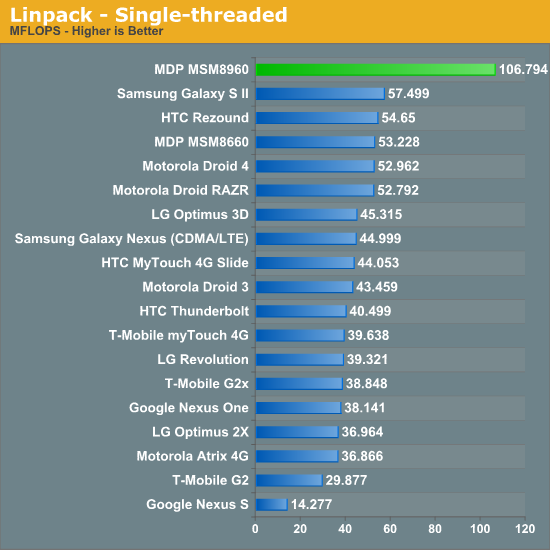
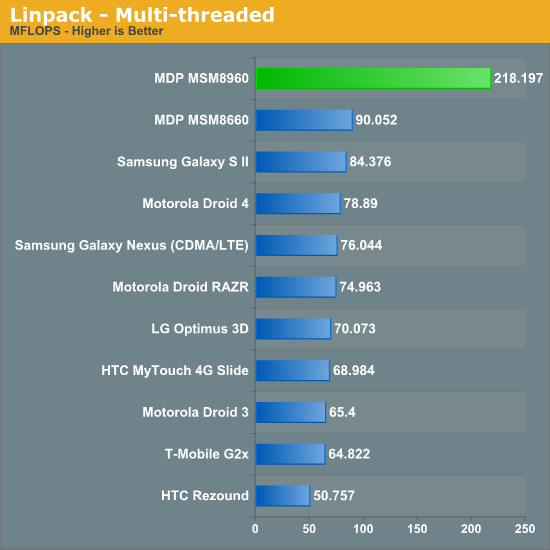
Occasionally we'll see performance numbers that just make us laugh at their absurdity. Krait's Linpack performance is no exception. The performance advantage here is insane. The MSM8960 is able to deliver more than twice the performance of any currently shipping SoC. The gains are likely due in no small part to improvements in Krait's cache/memory controller. Krait can also issue multi-issue FP instructions, A9 class architectures can apparenty only dual-issue integer instructions.
Moving on we have our standard JavaScript benchmarks: Sunspider and Browsermark. Both of these tests show significant performance improvements, although understandably not by the margins we saw above in Linpack:
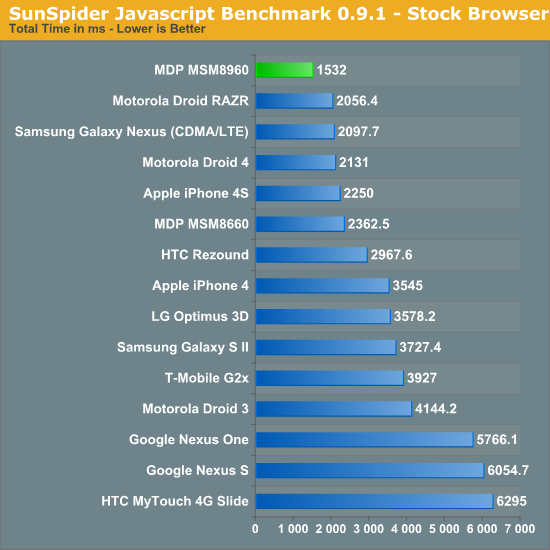
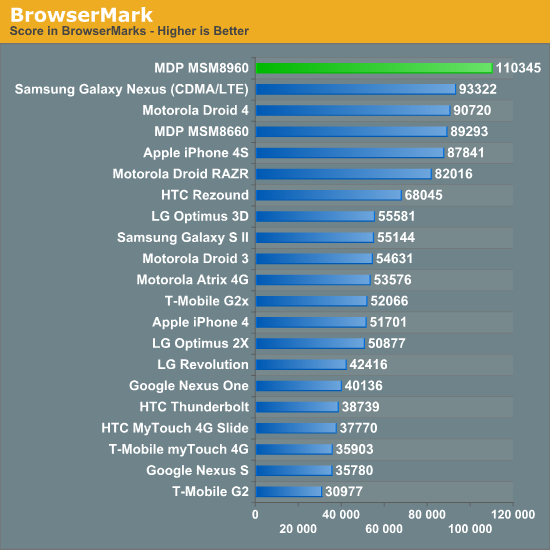
Krait and the MSM8960 are 20 - 35% faster than the dual-core Cortex A9s used in Samsung's Galaxy Nexus. For a look at how overall web page loading is impacted we loaded AnandTech.com three times and averaged the results. We presented results with the browser cache cleared after each run as well as results after all assets were cached:
| AnandTech.com Page Loading Comparison (Stock ICS Browser) | ||||
| Browser Cache Cleared | Cache In Use | |||
| Qualcomm MDP MSM8960 (Krait) | 5.5 seconds | 3.0 seconds | ||
| Samsung Galaxy Nexus (ARM Cortex A9) | 5.8 seconds | 4.4 seconds | ||
There's hardly any advantage when you're network bound, which is to be expected. However whenever the device can pull assets from a local cache (something that is quite common as images, CSS and even many page elements remain static between loads) the advantage grows considerably. Here we're seeing a 46% advantage from Krait over the Cortex A9 in the Galaxy Nexus.
We turn to Qualcomm's own Vellamo as a system/CPU/browser performance test:
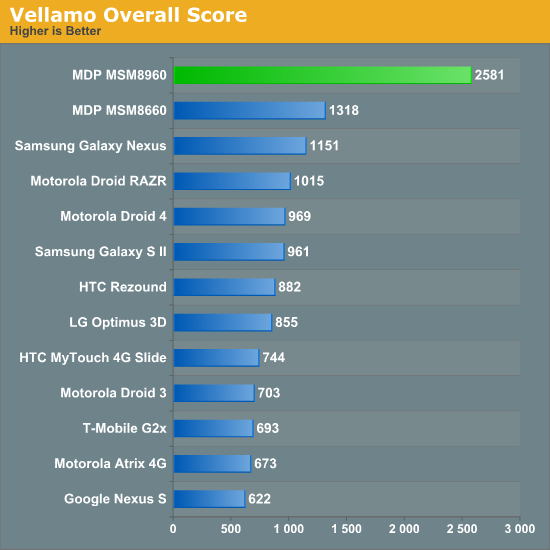
Again, we're showing a huge performance advantage here thanks to Krait. Seeing as how Vellamo is a Qualcomm benchmark don't get too attached to the advantage here, but it does echo some of what we've seen earlier.
Finally we have Rightware's Basemark OS 1.1 RC which is fast becomming an impressively polished system benchmark, one which will hopefully eventually take the place of the likes of Quadrant.
| Basemark OS - System | |||
| HTC Rezound | Galaxy Nexus | MDP MSM8960 | |
| System Overall Score | 658 | 538 | 907 |
| Simple Java 1 | 298 loops/s | 210 loops/s | 375 loops/s |
| Simple Java 2 | 7.28 loops/s | 8.61 loops/s | 10.8 loops/s |
| SMP Test | 35.3 loops/s | 49.2 loops/s | 64.4 loops/s |
| 100K File (eMMC->SD) | 6.49 mB/s | 9.52 mB/s | 8.64 mB/s |
| 100K File (SD->eMMC) | 33.0 mB/s | 17.8 mB/s | 39.8 mB/s |
| 100K File (eMMC->eMMC) | 37.8 mB/s | 34.5 mB/s | 48.9 mB/s |
| 100K File (SD->SD) | 8.47 mB/s | 8.30 mB/s | 12.7 mB/s |
| Database Operation | 10.0 ops/s | 5.73 ops/s | 19.4 ops/s |
| Zip Compression | 0.509 s | 0.848 s | 0.561 s |
| Zip Decompression | 0.097 s | 0.206 s | 0.073 s |
On the CPU centric tests Basemark OS is showing anywhere from a 20% - 80% increase in performance over the 1.5 GHz APQ8060 based HTC Rezound. IO performance is also tangibly improved although that could be a function of NAND performance rather than the SoC specifically.
These results as a whole simply quantify what we've felt during our use of the MSM8960 MDP: this is the absolute smoothest we've ever seen Ice Cream Sandwich run.










86 Comments
View All Comments
BaronMatrix - Tuesday, February 21, 2012 - link
We can look at the perf of CedarTrail or Ivy Blossom or whatever. Since Intel has said they are more so competing with Qualcomm. And this is only at 1.5GHz. When the 2.5Ghz chips come out with the new Adreno (Former ATi GPU), everyone will have to pack up and go home.iwod - Tuesday, February 21, 2012 - link
The rumors of Apple A5X leads some to suggest next iPad would not be 28nm SoC. So this prove we may still have chance of 28nm SoC coming in next iPad.Krait is bringing A15 level performance while being on a A9 class core?? Sorry i must be missing something. Or Since Krait is designed by Qualcomm A9 and A15 naming doesn't matter? (o.O)
No Mention of comparison to Intel newest Atom?
infra_red_dude - Tuesday, February 21, 2012 - link
Correct, Krait cannot be directly compared to A9 or A15 architecture. I think calling Krait contemporary to A15 is more correct than "A15/9-class" CPU.snoozemode - Tuesday, February 21, 2012 - link
It's really about time you can plug in your mobile to computer screen and run the Tablet UI, preferably at native resolution. Don't know what I would need this processing power to otherwise.tipoo - Tuesday, February 21, 2012 - link
This is very obviously faster than something like the Tegra 3 in single or dual threaded performance, I wonder how many apps take advantage of more than two threads on Android or iOS? I'm guessing for the foreseeable future faster duals will win out.remixfa - Tuesday, February 21, 2012 - link
Can Brian Klug & Anand Lal Shimpi please clarify for me which version of the SGS2 is being used? Its a very pertinent question. Is it the i9000 with the 1.2ghz Exynos chip or the American Hercules T989/Skyrocket variants that have the lesser Snapdragon 1.5ghz chips in them.Judging from the benchmarks, it really makes me think its the hercules/skyrocket. That really needs to be clarified, since unfortunately not all SGS2s are created equal.
Brian Klug - Tuesday, February 21, 2012 - link
The SGS2 used in the article is the UK SGS2 with Exynos 4210 inside.-Brian
larry6hi5 - Tuesday, February 21, 2012 - link
On page 1 of the article, the first table gives the MSM8660 as running at 1.5 GHz. Shouldn't this be 1.0 GHz?Brian Klug - Tuesday, February 21, 2012 - link
That's because the MSM8660 is indeed at 1.5 GHz :)If you go back to our original MDP article we note it there: http://www.anandtech.com/show/4243/
And also the official MDP MSM8660 page: https://developer.qualcomm.com/develop/development...
-Brian
ncb1010 - Tuesday, February 21, 2012 - link
"Even at its lower native resolution, Apple's iPhone 4S is unable to outperform the MSM8960 based MDP here"1024 x 600 = 614,400 pixels
960 x 640 = 614,400 pixels
There is no basis for saying the iPhone 4S has a lower resolution than this MDP being evaluated.